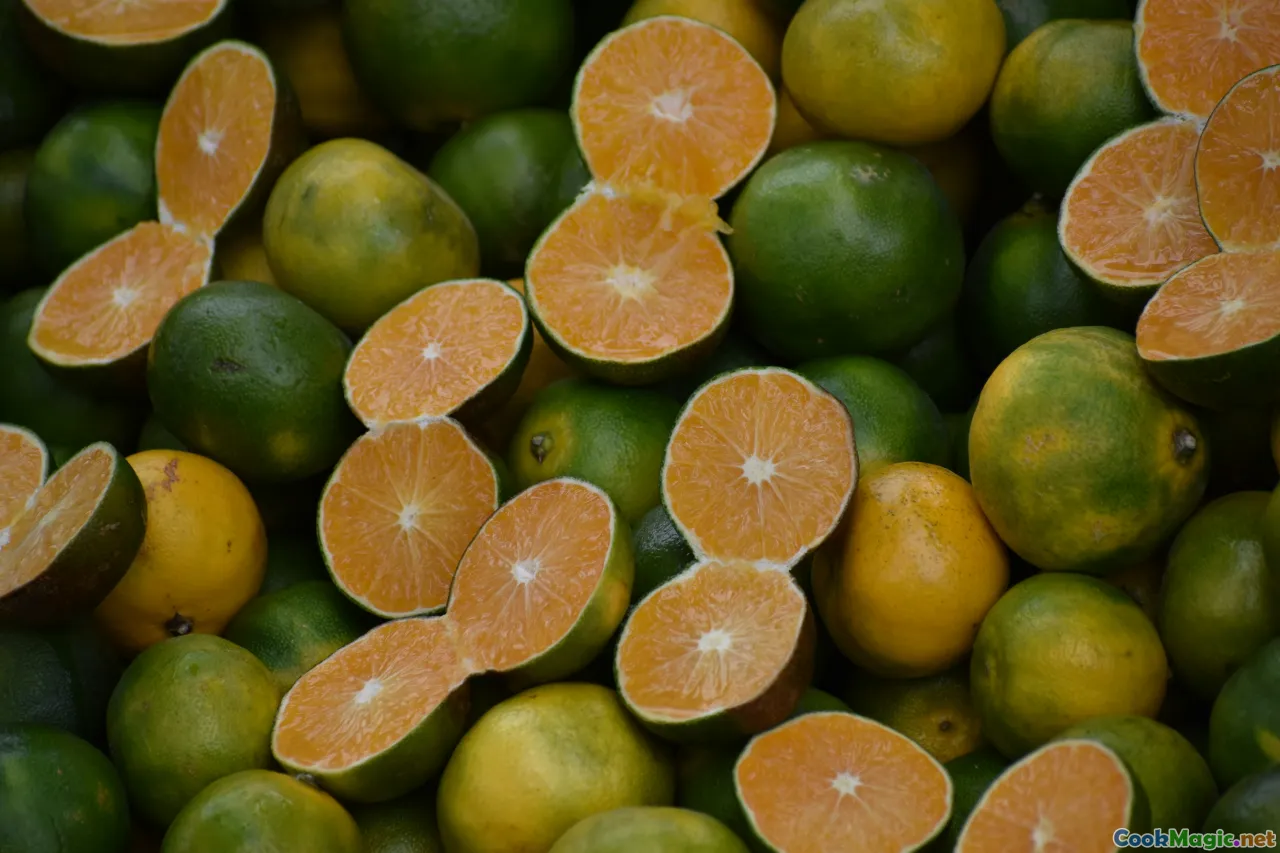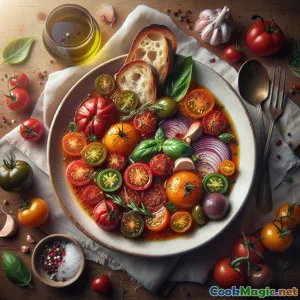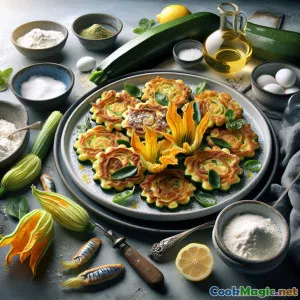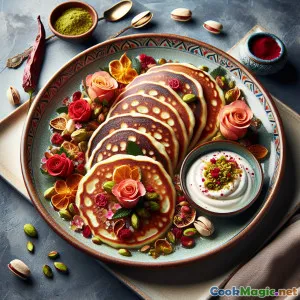
Delicia de Cannoli siciliano con flor de azahar
(Sicilian Orange Blossom Cannoli Delight)
(0 Reseñas)0
182
octubre 10, 2025
Informar de un problema
Ingredientes
-
250 grams Harina de trigo común
(Unbleached preferred for better texture)
-
30 grams Azúcar granulado
(Adds slight sweetness to shells)
-
5 grams Cacao en polvo sin azúcar
(For color and depth; traditional in some regions)
-
0.25 tsp Canela molida
(Warm spice note in shells)
-
0.25 tsp sal de mar fino
(Equilibra la dulzura)
-
30 grams Mantequilla fría sin sal (o manteca de cerdo)
(Lard is traditional and crisps shells)
-
1 piece Huevo grande
(For dough structure)
-
80 ml Vino Marsala
(Classic liquid; dry white wine works in a pinch)
-
15 ml Vinagre blanco
(Encourages blistered, bubbly shells)
-
10-20 ml Agua
(Only if needed to bring dough together)
-
1 piece Clara de huevo
(To seal shells on molds)
-
1 liter Aceite neutro para freír
(Peanut, sunflower, or canola)
-
500 grams Ricotta de leche de oveja (bien escurrida)
(Cow’s milk ricotta acceptable if thoroughly drained)
-
120 grams Azúcar en polvo
(Sifted; adjust to taste)
-
7 ml agua de azahar
(Fragrant; start small and adjust to taste)
-
1 tbsp Ralladura fina de naranja
(Use untreated, fragrant oranges)
-
60 grams Piel de naranja confitada, picada en cubos
(Adds texture and citrus intensity)
-
1 tsp Extracto de vainilla pura
(Enhances ricotta sweetness)
-
60 grams Mini chispas de chocolate negro
(Optional mix-in for contrast)
-
80 grams Pistachos, picados finamente
(For dipping the ends)
-
12 pieces Cerezas confitadas
(Traditional garnish for presentation)
-
15 grams Azúcar glas (para espolvorear)
(Light final dusting)
(Unbleached preferred for better texture)
(Adds slight sweetness to shells)
(For color and depth; traditional in some regions)
(Warm spice note in shells)
(Equilibra la dulzura)
(Lard is traditional and crisps shells)
(For dough structure)
(Classic liquid; dry white wine works in a pinch)
(Encourages blistered, bubbly shells)
(Only if needed to bring dough together)
(To seal shells on molds)
(Peanut, sunflower, or canola)
(Cow’s milk ricotta acceptable if thoroughly drained)
(Sifted; adjust to taste)
(Fragrant; start small and adjust to taste)
(Use untreated, fragrant oranges)
(Adds texture and citrus intensity)
(Enhances ricotta sweetness)
(Optional mix-in for contrast)
(For dipping the ends)
(Traditional garnish for presentation)
(Light final dusting)
Nutrición
- Porciones: 12
- Tamaño de porción: 1 filled cannolo (90g)
- Calories: 290 kcal
- Carbohydrates: 0 g
- Protein: 6 g
- Fat: 18 g
- Fiber: 1 g
- Sugar: 12 g
- Sodium: 95 mg
- Cholesterol: 35 mg
- Calcium: 90 mg
- Iron: 1.1 mg
Instrucciones
-
1 - Drain the ricotta:
Line a sieve with cheesecloth, add ricotta, and let drain in the refrigerator to remove excess moisture. If short on time, gently press with paper towels.
-
2 - Combine Dry Ingredients:
In a bowl, whisk flour, sugar, cocoa powder, cinnamon, and salt until evenly blended.
-
3 - Cut in fat:
Rub cold butter (or lard) into the dry mix with fingertips until it resembles coarse crumbs.
-
4 - Form the Dough:
Whisk egg, Marsala, and vinegar. Add to flour mixture and knead briefly until smooth. Add a splash of water only if crumbly. The dough should be firm.
-
5 - Rest the Dough:
Wrap dough and rest at room temperature to relax gluten for easier rolling and better blistering.
-
6 - Roll and Cut:
Divide dough. Using a pasta machine or rolling pin, roll to 1–2 mm thickness. Cut 9–10 cm rounds (or ovals), re-rolling scraps as needed.
-
7 - Wrap on molds:
Lightly oil cannoli tubes. Wrap each dough round around a tube; brush the overlapping edge with egg white and press to seal. Do not wrap too tightly.
-
8 - Fry shells:
Heat oil to 175°C/350°F. Fry 2–3 shells at a time for 1–2 minutes until deeply golden and blistered. Drain on a rack and cool completely.
-
9 - Remove molds and store shells:
Gently slide shells off tubes. Store fully cooled shells in an airtight container to keep crisp.
-
10 - Make orange blossom ricotta:
Beat drained ricotta with powdered sugar until smooth. Fold in orange blossom water, orange zest, vanilla, and candied orange. Add chocolate chips if using. Chill 15 minutes.
-
11 - Fill the cannoli:
Pipe ricotta into each shell from both ends for a complete fill. Do this just before serving to maintain crispness.
-
12 - Garnish and Serve:
Dip ends into chopped pistachios, top with a candied cherry if desired, and dust lightly with powdered sugar. Serve immediately.
Line a sieve with cheesecloth, add ricotta, and let drain in the refrigerator to remove excess moisture. If short on time, gently press with paper towels.
In a bowl, whisk flour, sugar, cocoa powder, cinnamon, and salt until evenly blended.
Rub cold butter (or lard) into the dry mix with fingertips until it resembles coarse crumbs.
Whisk egg, Marsala, and vinegar. Add to flour mixture and knead briefly until smooth. Add a splash of water only if crumbly. The dough should be firm.
Wrap dough and rest at room temperature to relax gluten for easier rolling and better blistering.
Divide dough. Using a pasta machine or rolling pin, roll to 1–2 mm thickness. Cut 9–10 cm rounds (or ovals), re-rolling scraps as needed.
Lightly oil cannoli tubes. Wrap each dough round around a tube; brush the overlapping edge with egg white and press to seal. Do not wrap too tightly.
Heat oil to 175°C/350°F. Fry 2–3 shells at a time for 1–2 minutes until deeply golden and blistered. Drain on a rack and cool completely.
Gently slide shells off tubes. Store fully cooled shells in an airtight container to keep crisp.
Beat drained ricotta with powdered sugar until smooth. Fold in orange blossom water, orange zest, vanilla, and candied orange. Add chocolate chips if using. Chill 15 minutes.
Pipe ricotta into each shell from both ends for a complete fill. Do this just before serving to maintain crispness.
Dip ends into chopped pistachios, top with a candied cherry if desired, and dust lightly with powdered sugar. Serve immediately.
Más información sobre: Delicia de Cannoli siciliano con flor de azahar
Sicilian Orange Blossom Cannoli
These Sicilian Orange Blossom Cannoli bring the sun-drenched citrus groves of the Mediterranean straight to your table. Crisp, blistered shells cradle a velvety ricotta cream delicately perfumed with orange blossom water, enhanced by zesty orange peel and the jeweled crunch of pistachios. Every bite is a play of textures and aromas—crackling pastry, soft cream, bright floral notes, and a nutty finish—that celebrates Sicily’s love affair with citrus and craftsmanship.
Why this recipe works
- The dough uses Marsala wine and a touch of vinegar to encourage signature blisters and a shatteringly crisp shell.
- Properly drained ricotta yields a smooth, stable filling that doesn’t weep into the shells.
- Orange blossom water adds a whisper of floral perfume that elevates the traditional ricotta, harmonizing with grated zest and candied orange.
- Filling at the last minute preserves crunch and contrast.
Chef’s tips
- Drain the ricotta thoroughly: Excess moisture is the enemy of crisp shells. If possible, drain overnight in the refrigerator.
- Roll thin: Aim for 1–2 mm thickness. A pasta machine ensures consistency and maximizes blistering.
- Oil temperature control: Keep the oil around 175°C/350°F. Too cool and shells absorb oil; too hot and they brown before blistering.
- Seal smartly: Just a brush of egg white is enough. Over-sealing can make shells dense where they overlap.
- Flavor balance: Orange blossom water is potent—start with less, taste, and adjust. You want a gentle floral note, not perfume.
- Storage: Store empty shells air-tight for up to 4 days. Fill only just before serving. The ricotta mixture keeps refrigerated (covered) for 2 days.
- Garnishes: Pistachios are classic, but you can alternate with candied orange shards or dip one end in dark chocolate for a dramatic finish.
Ingredient notes
- Ricotta: Traditionalists favor sheep’s milk ricotta for a richer, slightly tangier profile. Cow’s milk ricotta works; just dry it well.
- Marsala wine: Its mild sweetness and complexity help with both blistering and flavor. Dry white wine is an acceptable substitute.
- Lard vs. butter: Lard yields ultra-crisp shells with classic flavor; butter lends a subtle dairy note and is more accessible.
- Candied orange peel: Seek high-quality peel with a bright citrus aroma to complement orange blossom.
History and cultural significance
Cannoli likely trace their origins to Sicily’s Arab-influenced period, where sweets fragranced with citrus, honey, and floral waters flourished. Over centuries, the pastry evolved from festive “carnevale” fare to a beloved year-round treat. Today, cannoli are ubiquitous in Sicilian pasticcerie, often filled to order and studded with pistachios from Bronte, a town famed for its emerald-green nuts. Orange blossom water nods to the island’s orange groves and Moorish culinary legacy—its floral nuance brings a sense of place that is distinctly Sicilian.
Technique spotlight: achieving the perfect shell
- Resting the dough: This relaxes gluten and improves extensibility, ensuring thin, even rolling.
- Thinness and shape: Ovals produce a slightly tapered cannolo; circles are easier for beginners. Either way, keep them thin for bubbles.
- Frying: Use a deep pot, maintain temperature, and fry in small batches. Rotate shells gently with tongs to color evenly.
- Cooling: Let shells cool fully before removing the molds to avoid cracking.
Serving suggestions
- Espresso pairing: The bitterness of a short espresso offsets the cream’s sweetness.
- Citrus trio: Serve with segments of blood orange or a drizzle of orange honey for layered citrus flavor.
- Festive platter: Alternate pistachio-dipped ends with ends rolled in candied orange or cocoa nibs for color and texture.
Troubleshooting
- Soggy shells: The filling was too wet or added too early. Drain ricotta longer and fill just before serving.
- Shells not blistered: Dough too thick or oil too cool. Roll thinner and verify oil temperature.
- Filling too loose: Add a little more powdered sugar or briefly fold in a spoonful of mascarpone for extra body (nontraditional but effective).
Make-ahead and scaling
- Shells can be made days in advance and kept airtight with a silica packet to retain crispness.
- The filling can be mixed a day ahead, but add orange blossom water closer to serving to keep the aroma vibrant.
- Scale the recipe by maintaining the same dough hydration; avoid adding too much liquid, which diminishes blistering.
Personal note
There’s an alchemy in the way orange blossom water transforms humble ricotta. It’s subtle yet unmistakable—a breath of Sicilian spring in a pastry that crackles as you bite. These cannoli are indulgent but balanced, marrying tradition with a fragrant flourish that feels both timeless and new. When I serve them, I watch for that pause—the quiet moment when floral citrus meets crisp pastry—and I’m reminded why some classics endure: they carry stories of place, season, and craftsmanship in every bite.

























